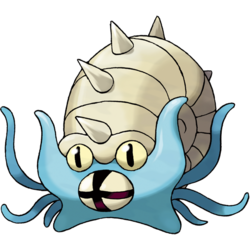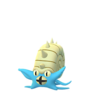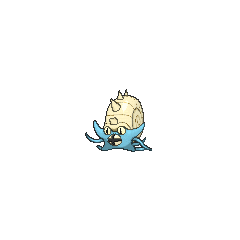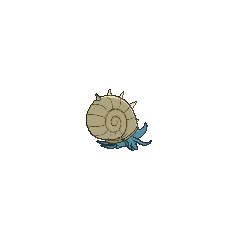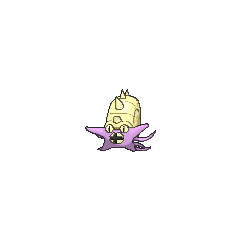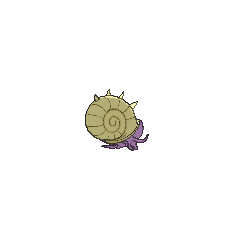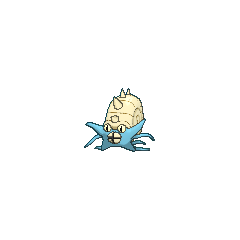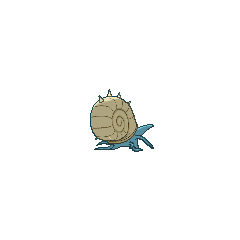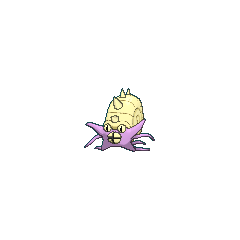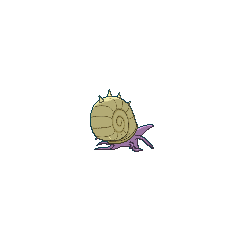From Bulbapedia, the community-driven Pokémon encyclopedia.
|
|
| Line 491: |
Line 491: |
| |candy=Omanyte | | |candy=Omanyte |
| |evolution=N/A | | |evolution=N/A |
| |stamina=140 | | |stamina=172 |
| |attack=207 | | |attack=207 |
| |defense=227 | | |defense=201 |
| |fast={{m|Mud Shot}}{{tt|*|From August 20, 2016 onwards}}, {{m|Rock Throw}}{{tt|*|Prior to August 20, 2016}}, {{m|Water Gun}} | | |fast={{m|Mud Shot}}{{tt|*|From August 20, 2016 onwards}}, {{m|Water Gun}} |
| |special={{m|Ancient Power}}, {{m|Hydro Pump}}, {{m|Rock Slide}}{{tt|*|Prior to February 16, 2017}}, {{m|Rock Blast}}{{tt|*|From February 16, 2017 onward}} | | :{{m|Rock Throw}}{{tt|*|Prior to August 20, 2016}} |
| | |special={{m|Ancient Power}}, {{m|Hydro Pump}}, {{m|Rock Blast}}{{tt|*|From February 16, 2017 onward}} |
| | :{{m|Rock Slide}}{{tt|*|Prior to February 16, 2017}} |
| }} | | }} |
| |} | | |} |
Revision as of 04:30, 24 September 2019
Omastar (Japanese: オムスター Omstar) is a dual-type Rock/Water Fossil Pokémon introduced in Generation I.
It evolves from Omanyte starting at level 40, after it is revived from a Helix Fossil.
Biology
Omastar is a Pokémon similar to an ammonite. Its sky blue body has several tentacles; the tentacles toward the front are shorter and thicker than those in the back. There is a pale yellow, helix spiraled shell on its back. Several sharp spikes line the shell's midsection from the front to about halfway down its back. The shell's rim has two circular indents where Omastar's eyes are visible. Its eyes have yellow sclerae and vertically-slit pupils. It has an oval mouth with a four-sectioned, fang-like beak.
It is believed that Omastar's extinction was a consequence of the increasingly heavy weight of its own shell that affected its mobility, including its hunting. Omastar swam the seas in search of prey, including prehistoric Shellder. Omastar's used it tentacles to ensnare its prey before biting down with the deadly force of its beak. With the shell broken, it would suck out the contents. Omastar was in turn preyed upon by Carracosta. Omastar is thought to be a distant ancestor to Octillery.
In the anime
Major appearances
Two Omastar debuted in Attack of the Prehistoric Pokémon, alongside all of the other Generation I Fossil Pokémon. They were sleeping under Grampa Canyon until a dynamite blast woke them up. The Rock/Water-type Fossil Pokémon chased Ash Ketchum and Team Rocket until Aerodactyl showed up and scared them off.
Multiple Omastar appeared in Fossil Fools, alongside their pre-evolved form Omanyte. These Pokémon were discovered to be living in the Ruins of Alph, but they were moved into a museum.
An Omastar appeared in Dealing With Defensive Types! in the Canalave Gym. It caught Team Rocket trying to steal food from the Gym kitchen whilst Ash was having his Gym battle with Byron, and attacked them with Water Gun, sending them blasting off.
Minor appearances
A Omastar appeared in Pikachu's Vacation as one of the Pokémon seen at the Pokémon Theme Park.
An Omastar appeared in Team Rocket's fantasy in Imitation Confrontation.
An Omastar appeared in a fantasy in A Ruin with a View.
An Omastar appeared in a fantasy in Where's Armaldo?.
An Omastar appeared in Lucario and the Mystery of Mew as one of the Pokémon living in the Tree of Beginning. Also, one appeared in the opening sequence of the movie.
Dr. Yung uses a Mirage Omastar in The Mastermind of Mirage Pokémon.
Pokédex entries
| Episode
|
Pokémon
|
Source
|
Entry
|
| EP046
|
Omanyte, Omastar, Kabuto, and Kabutops
|
Ash's Pokédex
|
Omanyte and Omastar, Kabuto and Kabutops. It is believed these Pokémon became extinct tens of thousands of years ago. The details of their behavior is shrouded in mystery. Though some have speculated that they may still exist, none of these Pokémon have ever been seen alive.
|
|
| Episode
|
Pokémon
|
Source
|
Entry
|
| EP163
|
Omastar
|
Ash's Pokédex
|
Omastar, the evolved form of Omanyte. This extinct Pokémon is believed to have used its sharp fangs to break through the shells of its prey in order to feed.
|
|
In the manga
In the Pokémon Adventures manga
- Main article: Omny
Yellow has an Omastar, nicknamed Omny, who she originally obtained from Misty as an Omanyte. He evolved into an Omastar by The Might of... Metapod?!.
In the TCG
- Main article: Omastar (TCG)
Game data
NPC appearances
Pokédex entries
| Generation I
|
|
|
Kanto
#139
|
| Red(ENG)
|
A prehistoric Pokémon that died out when its heavy shell made it impossible to catch prey.
|
| Blue
|
| Yellow
|
Sharp beaks ring its mouth. Its shell was too big for it to move freely, so it became extinct.
|
| Stadium
|
Attacks by ensnaring its enemy with its tentacles and biting with sharp fangs. Its overly-large shell makes it sluggish.
|
|
|
| Generation II
|
|
|
Johto
#221
|
| Gold
|
Apparently, it cracked Shellder's shell with its sharp fangs and sucked out the insides.
|
| Silver
|
Once wrapped around its prey, it never lets go. It eats the prey by tearing at it with sharp fangs.
|
| Crystal
|
Its heavy shell allowed it to reach only nearby food. This could be the reason it is extinct.
|
| Stadium 2
|
Apparently, it cracked Shellder's shell with its sharp fangs and sucked out the insides.
|
|
|
| Generation III
|
|
Hoenn
#—
|
|
Kanto
#139
|
| Ruby
|
Omastar uses its tentacles to capture its prey. It is believed to have become extinct because its shell grew too large and heavy, causing its movements to become too slow and ponderous.
|
| Sapphire
|
| Emerald
|
An Omastar uses its tentacles to capture its prey. It is believed to have become extinct because its shell grew too large, making its movements slow and ponderous.
|
| FireRed
|
Its tentacles are highly developed as if they are hands and feet. As soon as it ensnares prey, it bites.
|
| LeafGreen
|
Despite having strong fangs and tentacles, it went extinct when its heavy shell made it unable to catch prey.
|
|
|
| Generation IV
|
|
Sinnoh
#—
|
|
Johto
#226
|
| Diamond
|
It is thought that this Pokémon became extinct because its spiral shell grew too large.
|
| Pearl
|
| Platinum
|
| HeartGold
|
Apparently, it cracked Shellder's shell with its sharp fangs and sucked out the insides.
|
| SoulSilver
|
Once wrapped around its prey, it never lets go. It eats the prey by tearing at it with sharp fangs.
|
|
|
| Generation V
|
|
|
Unova
#—
|
| Black
|
It is thought that this Pokémon became extinct because its spiral shell grew too large.
|
| White
|
| Black 2
|
It is thought that this Pokémon became extinct because its spiral shell grew too large.
|
| White 2
|
|
|
| Generation VI
|
|
Kalos
#—
|
|
Hoenn
#—
|
| X
|
Its tentacles are highly developed as if they are hands and feet. As soon as it ensnares prey, it bites.
|
| Y
|
Once wrapped around its prey, it never lets go. It eats the prey by tearing at it with sharp fangs.
|
| Omega Ruby
|
Omastar uses its tentacles to capture its prey. It is believed to have become extinct because its shell grew too large and heavy, causing its movements to become too slow and ponderous.
|
| Alpha Sapphire
|
|
|
| Generation VII
|
|
Alola
USUM: #228
|
|
Kanto
#139
|
| This Pokémon has no Pokédex entries in Sun and Moon.
|
| Ultra Sun
|
Its heavy shell is thought to be the reason this ancient Pokémon died out. It's apparently a distant ancestor of Octillery.
|
| Ultra Moon
|
It wraps its prey in its tentacles to immobilize them and then finishes them off with its sharp fangs.
|
| Let's Go Pikachu
|
Its sharp beak rings its mouth. Its shell was too big for it to move freely, so it became extinct.
|
| Let's Go Eevee
|
|
|
Game locations
In side games
|
|
| Generation II
|
|
| This Pokémon is unavailable in Generation II side games.
|
|
|
|
|
|
|
|
|
|
|
Held items
Stats
Base stats
| Stat
|
Range
|
| At Lv. 50
|
At Lv. 100
|
70
|
|
130 - 177
|
250 - 344
|
60
|
|
58 - 123
|
112 - 240
|
125
|
|
117 - 194
|
229 - 383
|
115
|
|
108 - 183
|
211 - 361
|
70
|
|
67 - 134
|
130 - 262
|
55
|
|
54 - 117
|
103 - 229
|
Total: 495
|
Other Pokémon with this total
|
- Minimum stats are calculated with 0 EVs, IVs of 0, and (if applicable) a hindering nature.
- Maximum stats are calculated with 252 EVs, IVs of 31, and (if applicable) a helpful nature.
- This Pokémon's Special base stat in Generation I was 115.
|
Pokéathlon stats
Type effectiveness
| Under normal battle conditions in Generation IX, this Pokémon is:
|
|
|
|
|
|
|
|
|
|
|
|
|
Learnset
|
|
|
|
- Bold indicates a move that gets STAB when used by Omastar
- Italic indicates a move that gets STAB only when used by an Evolution of Omastar
- Click on the generation numbers at the top to see level-up moves from other generations
|
|
|
|
|
- Bold indicates a move that gets STAB when used by Omastar
- Italic indicates a move that gets STAB only when used by an Evolution of Omastar
- Click on the generation numbers at the top to see TM moves from other generations
|
|
|
|
|
- Bold indicates a move that gets STAB when used by Omastar
- Italic indicates a move that gets STAB only when used by an Evolution of Omastar
- Click on the generation numbers at the top to see moves from other generations
|
|
|
|
|
- Bold indicates a move that gets STAB when used by Omastar
- Italic indicates a move that gets STAB only when used by an Evolution of Omastar
- Click on the generation numbers at the top to see level-up moves from other generations
|
|
|
|
|
- Bold indicates a move that gets STAB when used by Omastar
- Italic indicates a move that gets STAB only when used by an Evolution of Omastar
- Click on the generation numbers at the top to see TM moves from other generations
|
|
|
|
|
- Moves marked with an asterisk (*) must be chain bred onto Omastar in Generation VII
- Moves marked with a double dagger (‡) can only be bred from a Pokémon who learned the move in an earlier generation.
- Moves marked with a superscript game abbreviation can only be bred onto Omastar in that game.
- Bold indicates a move that gets STAB when used by Omastar
- Italic indicates a move that gets STAB only when used by an Evolution of Omastar
- Click on the generation numbers at the top to see Egg moves from other generations
|
|
|
|
|
- A black or white abbreviation in a colored box indicates that Omastar can be tutored the move in that game
- A colored abbreviation in a white box indicates that Omastar cannot be tutored the move in that game
- Bold indicates a move that gets STAB when used by Omastar
- Italic indicates a move that gets STAB only when used by an Evolution of Omastar
- Click on the generation numbers at the top to see Move Tutor moves from other generations
|
|
|
|
|
- Bold indicates a move that gets STAB when used by Omastar
- Italic indicates a move that gets STAB only when used by an Evolution of Omastar
- Click on the generation numbers at the top to see moves from other generations
|
TCG-only moves
Side game data
Evolution
Sprites
Trivia
- In early English-language promotional material for Pokémon Red and Blue, Omastar was originally known as "Kargo". This name is derived from "escargot" (French for snail).
- Omastar is the only Fossil Pokémon whose extinction has been explained: its shell was too heavy for it to move, leading it to die out from starvation.
- This explanation may also refer to the giant orthocone, ancestor to the modern octopus. The orthocone resembled a slow, cumbersome octopus with a long, pointed shell.
Origin
Omastar appears to be based on a type of ammonite. In addition, its method of grabbing prey and cracking their shells with ring-shaped mouths may be based on Anomalocaris.
Name origin
Omastar's name is a combination of a phonetic anagram of ammonite and star (based on its body shape).
Omstar is a combination of オウムガイ ōmugai (nautilus) and star.
In other languages
| Language
|
Title
|
Meaning
|
 Japanese Japanese
|
オムスター Omstar
|
From オウムガイ ōmugai and star
|
 French French
|
Amonistar
|
From ammonite and star
|
 Spanish Spanish
|
Omastar
|
Same as English name
|
 German German
|
Amoroso
|
From Ammonit
|
 Italian Italian
|
Omastar
|
Same as English name
|
 Korean Korean
|
암스타 Amsta
|
From Ammonite and star. 암 (岩) also means "rock", one of its types.
|
 Mandarin Chinese Mandarin Chinese
|
多刺菊石獸 / 多刺菊石兽 Duōcìjúshíshòu
|
Means "Spiky ammonite beast"
|
 Cantonese Chinese Cantonese Chinese
|
多刺菊石獸 Dōchigūksehksau
|
Means "Spiky ammonite beast"
|
|
|
|
| More languages
|
 Hindi Hindi
|
ओमास्टार Omastar
|
Transcription of English name
|
 Russian Russian
|
Омастар Omastar
|
Transcription of English name
|
|
|
|
Related articles
External links

|
This Pokémon article is part of Project Pokédex, a Bulbapedia project that aims to write comprehensive articles on each Pokémon species, as well as Pokémon groups and forms.
|


 For other sprites and images, please see Omastar images on the Bulbagarden Archives.
For other sprites and images, please see Omastar images on the Bulbagarden Archives.
